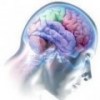An astonishing recent discovery in computational neuroscience is the relationship between dopamine and the "temporal differences" reinforcement learning algorithm (which Jake describes wonderfully here, and I've described in a little more detail here). The essential principle is that the difference between expected and received reward can be used to drive learning, and that this abstract learning theory can be tracked by the spikes and dips of dopamine in vivo (for under-expectation and over-expectation of reward, respectively).
However, one aspect of dopamine release is not accounted for by this reinforcement learning theory (as described here): dopamine is released in response to novelty, independent of the reward value of the novel items. This is related to an issue confronting agents driven solely by simple reinforcement learning mechanisms: these agents will exploit whatever they happen to learn, but will not attempt to explore novel aspects of their environment - and thus may miss out on items that are even more rewarding! No comprehensive learning theory based on neuroscientific evidence links dopamine with this "novelty problem," which is made all the more salient by our intuition that novelty in- and of-itself can be rewarding.
Of course, this problem is not unique to computational neuroscience - novelty is a neglected facet of many behavioral paradigms as well (as described fully here; in short, work examining categorization, generalization, rule-use and other functions frequently contain novelty confounds). Further complications arise from the fact that many of the same regions involved in these putative high-level cognitive processes are also involved in novelty processing.
One of the few studies to informatively address this problem is a 2005 study by Dobbins & Wagner, which focuses on the prefrontal correlates of novelty processing in a recollection paradigm. Specfically, Dobbins & Wagner distinguish those prefrontal mechanisms responsible for recollection from those involved in discriminating familiar and novel stimuli. As the authors review, a number of previous studies have implicated right prefrontal areas in "monitoring of a continuous or scalar familiarity signal in relation to an internal decision criterion," whereas others have proposed that right ventrolateral prefrontal cortex is more involved in discriminating perceptual features, as might be involved in determining whether something is novel (as in "have I seen that before?")
To dissociate these and other theories, Dobbins & Wagner first asked 14 subjects to assess whether certain items were living/nonliving, pleasant/unpleasant, or bigger/smaller than another item. Following this study phase, subjects saw sets of three items (one new, and two old) and had to either 1) pick the new item (as a test of novelty detection), 2) pick the item that had been discriminated as bigger/smaller (as a test of perceptual recollection), or 3) pick the item that had been discriminated as living/nonliving or pleasant/unpleasant (as a test of conceptual recollection). An interesting feature of this design is that the task itself is different depending on the condition, but the same cognitive processes may overlap between them (for example, one may always engage in perceptual recollection when determining whether something is novel).
The results mirrored this intuition: subjects showed greater involvement of a wide-spread but left-lateralized frontal network in recollection relative to novelty processing (involving frontopolar, dorsolateral, and posterior ventrolateral PFC, as well as the inferior parietal lobe), regardless of whether subjects were asked to recollect the item on which they'd made a perceptual or conceptual judgment. However, the recollection task was significantly more difficult for subjects than the novelty detection task (as indicated by much higher accuracy and lower reaction time), raising the possibility that novelty processing might also engage the same areas if it were made more difficult or had taken the same amount of time.
In contrast, the same areas which showed greater involvement in perceptual than conceptual recollection also showed greater involvement in novelty detection than conceptual recollection (including a region of right posterior ventrolateral prefrontal cortex). As mentioned above, subjects might engage retrieval in order to detect novelty (have I seen that before?). Consistent with this idea, no region of the right ventrolateral PFC was engaged more in any kind of recollection than in novelty detection. In addition, the hippocampus was involved in all three tests relative to fixation, but did not differentiate between them.
The following ideas are fairly speculative, since they rely on null effects reported Dobbins & Wagner. Nonetheless, it may be that the same hippocampal mechanisms support all of these tasks, including novelty detection. This jives with a number of theories of novelty detection, including those that rely on mismatch between retrieval cues and retrieved information in the hippocampus (a "comparator mechanism"), a familiarity detector in the surrounding perirhinal cortex (see this).
In frontal cortex, conceptual recollection appears to recruit distinct mechanisms from perceptual recollection and novelty detection, although the latter two are not dissociable in the right ventrolateral PFC. This too accords with previous work indicating that the generators of the mismatch negativity and/or p3a - psychophysiological phenomena which can be elicited by novel stimuli - may include the right inferior frontal gyrus.
In summary, Dobbins & Wagner have demonstrated a primarily right lateralized frontal network for perceptual processing (including, by theory, novelty detection) and a left lateralized frontoparietal network for conceptual processing. This pattern of lateralization can be understood from within multiple theoretical frameworks of lateralization, including perhaps the production-monitoring model described here.
I. G. Dobbins (2005). Domain-general and Domain-sensitive Prefrontal Mechanisms for Recollecting Events and Detecting Novelty Cerebral Cortex, 15 (11), 1768-1778 DOI: 10.1093/cercor/bhi054

This is an interesting post. What do you think are the implications on affective priming paradigms?
(please reply back at my blog, natering.blogspot.com)
Thanks,
Nate Ring
Campus Representative for Holy Cross College
Association for Psychological Science